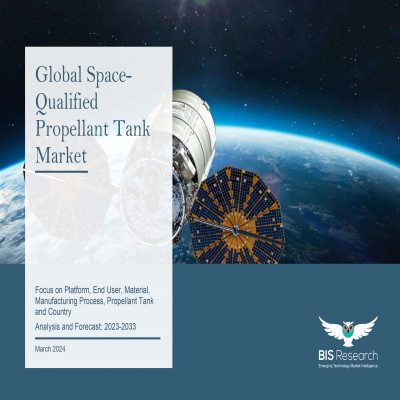Introduction to Europe Space-Qualified Propellant Tank Market
In 2023, the Europe Space-Qualified Propellant Tank Market was valued at $403.2 million and is expected to reach $501.8 million by the end of 2033, growing at a CAGR of 2.21% during the forecast period 2023-2033. Space-qualified propellant tanks, which are made to withstand the demanding requirements of space missions, are crucial parts of European aerospace engineering. The fuel required for spaceship propulsion is stored in these tanks, allowing for operations like deep space exploration, orbit modifications, and deorbiting. To guarantee dependability, safety, and effectiveness in the demanding environment of space, their design and production need for cutting-edge materials and technology.
Tanks that can endure high pressures, temperatures, and the corrosive character of different propellants have been developed as a result of recent developments in materials science. In an effort to lessen the environmental impact of space missions, leading manufacturers like Benchmark Space Systems and research institutes like the ?ukasiewicz Institute of Aviation are spearheading innovation in propulsion systems employing green propellants like high-test peroxide (HTP).
The successful use of these tanks in European space missions underscores the importance of reliable propellant storage solutions as satellite technology and interplanetary exploration continue to expand. Design considerations, including material selection and structural integrity, are critical for mission success, balancing performance, cost, and manufacturability. As the European space industry focuses on sustainability and efficiency, space-qualified propellant tanks will remain essential in powering the next generation of spacecraft, supporting further exploration and utilization of outer space.
Market Introduction
The market for space-qualified propellant tanks in Europe is expanding rapidly due to the rising need for sophisticated propulsion systems for space missions. Designed to hold propellants required for spacecraft propulsion, including orbital corrections, deorbiting, and deep space exploration, these tanks are essential parts of aeronautical engineering. The increasing number of interplanetary missions, satellite launches, and technological developments in space exploration are driving the market.
For space-qualified propellant tanks to withstand the harsh conditions of space, such as high pressures, temperature swings, and exposure to corrosive propellants, they must fulfill strict performance, safety, and reliability requirements. Tanks that can survive these challenging conditions while preserving efficiency and lessening their environmental impact have been developed as a result of recent advancements in materials science. Manufacturers in Europe, including Benchmark Space Systems, and research institutions like the ?ukasiewicz Institute of Aviation, are pioneering efforts to integrate green propellants and sustainable technologies into propulsion systems.
As space exploration continues to expand, the role of space-qualified propellant tanks becomes even more critical. These tanks are essential for ensuring the success of space missions, including satellite deployment, scientific research, and the push for interplanetary exploration. The increasing emphasis on sustainability, cost-effectiveness, and performance within the European space industry further accelerates the demand for innovative propellant storage solutions, positioning the market for continued growth.
Market Segmentation
Segmentation 1: by Platform
• Satellite
o 0-500 kg
o 501-1,000 kg
o 1,001 kg and Above
• Launch Vehicle
o Small Lift Launch Vehicle (0-2,200 kg)
o Medium and Heavy Lift Launch Vehicle (2,201 kg and Above)
Segmentation 2: by Propellant Tank
• Diaphragm Tanks
• Propellant Management Devices
• Helium, Nitrogen and Xenon Tanks
• Aluminum Alloy Tanks
• Hydrazine Tanks
• HTP Tanks
Segmentation 3: by Region
• Europe - U.K., Germany, France, Russia, and Rest-of-the-Europe

